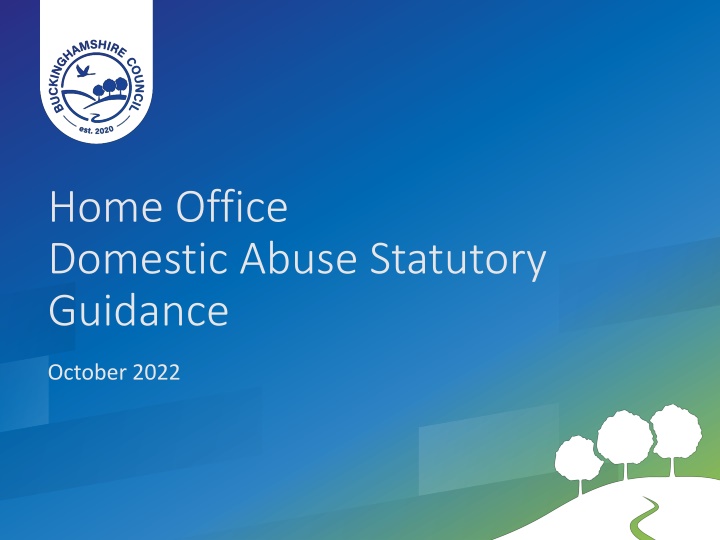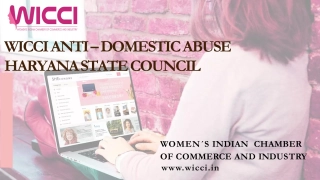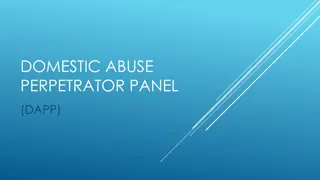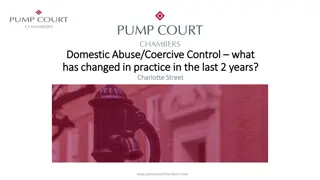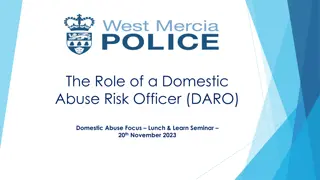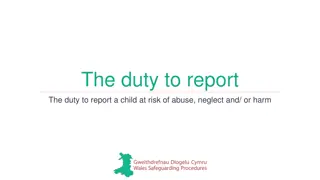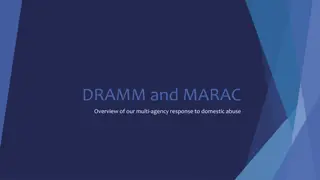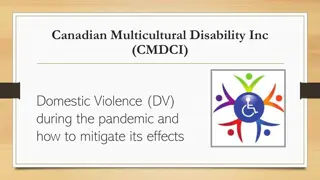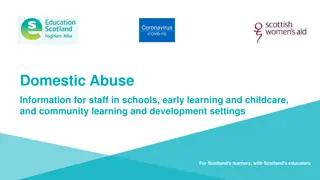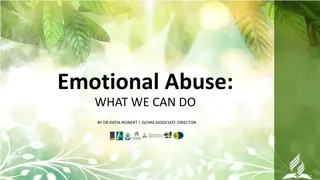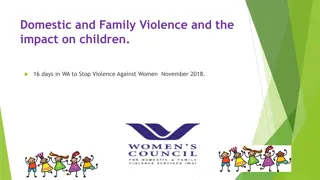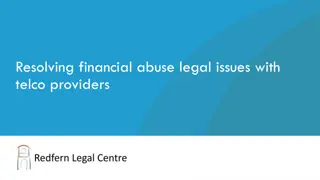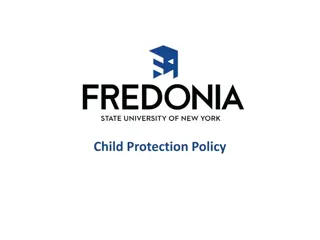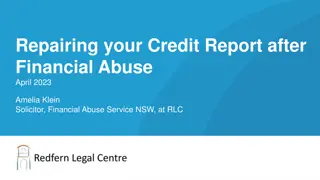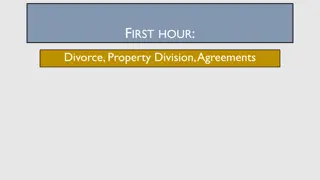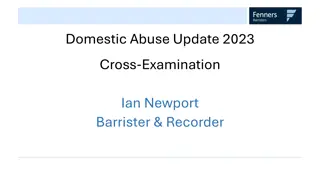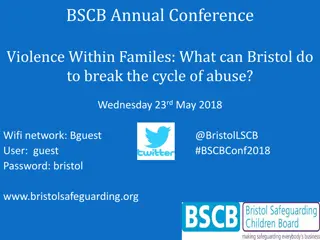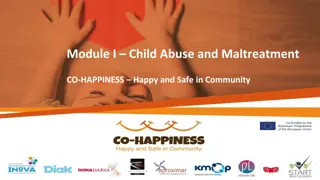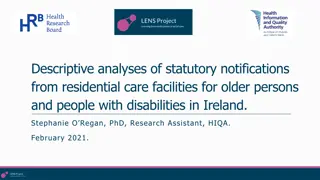Domestic Abuse: Statutory Guidance Overview
The statutory guidance issued under the Domestic Abuse Act 2021 aims to increase awareness and inform responses to domestic abuse. It outlines objectives such as promoting awareness, protecting and supporting victims, holding perpetrators accountable, transforming justice responses, and improving performance. The guidance provides clear information on domestic abuse identification and offers guidance on various aspects related to domestic abuse. Organisations working with victims, perpetrators, and commissioning services are encouraged to follow this guidance to effectively address domestic abuse situations.
Download Presentation

Please find below an Image/Link to download the presentation.
The content on the website is provided AS IS for your information and personal use only. It may not be sold, licensed, or shared on other websites without obtaining consent from the author.If you encounter any issues during the download, it is possible that the publisher has removed the file from their server.
You are allowed to download the files provided on this website for personal or commercial use, subject to the condition that they are used lawfully. All files are the property of their respective owners.
The content on the website is provided AS IS for your information and personal use only. It may not be sold, licensed, or shared on other websites without obtaining consent from the author.
E N D
Presentation Transcript
Click to edit Master title style Click to edit Master title style Home Office Domestic Abuse Statutory Guidance Click to edit Master subtitle style Click to edit Master subtitle style 25/02/2025 October 2022 1 25/02/2025 1
Introducing the Statutory Guidance Purpose The statutory guidance is issued under section 84 of the Domestic Abuse Act 2021 and is intended to increase awareness and inform the response to domestic abuse The Act (S84) requires professionals exercising public functions to carry out the guidance as specified to the types of organisations set out in the guidance Audience Organisations working with victims, perpetrators and commissioning services Includes the Police, local authorities, NHS, specialist DA & SV Services, early years, childcare and educational establishments, Social Care (Adults and Children), YOS and employers BUCKINGHAMSHIRE COUNCIL
Chapter 1- Objectives OBJECTIVES OF THE DA ACT 2021 Promote awareness- introducing a statutory definition which includes economic abuse and children as victims in their own right Protect and support victims- Establishing the Office of the DA Commissioner, new DAPN and DAPO and placing a new duty on Tier 1 local authorities to provide support to victims in refuges and other safe accommodation Hold perpetrators to account- Extending controlling or coercive behaviour to cover post- separation abuse, and extending the office of private sexual photographs to cause distress, introduction of new offence of non-fatal strangulation and by restating in statute that a person may not consent to being subjected to serious harm and therefore unable to consent to their own death Transform the justice response- use of video evidence, screens and special measures and ensuring victims of abuse are not subjected to further trauma by being cross-examined by the perpetrator Improve performance- Including by putting Domestic Violence Disclosure Scheme (DVDS) on a statutory footing and a statutory code of practice relating to the processing of DA data for immigration purposes BUCKINGHAMSHIRE COUNCIL
Chapter 1- Objectives OBJECTIVES OF THE DA STATUTORY GUIDANCE 1. Provide clear information on what domestic abuse is and how to identify it 2. Provide guidance and support to frontline professionals, and other organisations, including signposting to further resources 3. Convey standards and promote best practice for agency and multiagency response BUCKINGHAMSHIRE COUNCIL
Chapter 2- Understanding DA DA is a high harm, high volume crime that remains largely hidden The police recorded over 1.5 million domestic abuse related incidents and crimes in England and Wales in the year ending March 2021 Includes controlling or coercive behaviour, harassment, stalking, criminal damage, physical assault, sexual assault, rape and murder Anyone can be a victim of DA regardless of age, disability, sex, sexual orientation, gender identity, gender reassignment, race, religion or belief The majority of domestic homicide victims are women. Definition (in notes section below) Domestic abuse most commonly takes place in intimate partner relationships and can continue or intensify after a relationship has ended (or in the process of ending). It can also take place by family members and through child to parent abuse Teenage relationship abuse is not defined in the Act. However if the victim and perpetrator are at least 16 years old then abuse can fall under the statutory definition of domestic abuse. Whilst young people can be in relationships under the age of 16, it would be considered child abuse BUCKINGHAMSHIRE COUNCIL
Chapter 3- Recognising Domestic Abuse DA does not have to be physical acts of violence and can include threatening behaviour, controlling or coercive behaviour, emotional, psychological, sexual and/or economic abuse Physical abuse is being punched, slapped, poisoned, drowned, burned, objects thrown (list inexhaustive and will be used as threats) It is a perpetrator exerting power and control upon a victim and the cyclical pattern/frequency of these types of abuses to re-establish control where they feel control is being lost The DA Act 2021 created the offence of non-fatal strangulation. It is a high risk marker on the DASH risk assessment. Technologically- facilitated DA is experienced by 1 in 6 women who are victim of DA and includes setting up false social media accounts, placing false information online, hacking and use of spyware Honour Based Violence, Forced Marriage and FGM included as offences BUCKINGHAMSHIRE COUNCIL
Chapter 4- Impact of Domestic Abuse Domestic abuse can cause serious and devastating short and long term physical, mental, emotional and psychological health impacts on adults and children Depression, anxiety, PTSD, sleeping and eating disorders are associated with DA The severity and time span of the abuse and existing mental health needs of the victim are risk factors for suicidal ideation and subsequent attempts Some victims develop addition to alcohol and/or drugs and use them as a coping mechanism. Perpetrators may try to sustain a victim s dependency There are links between women s experiences of DA and offending and reoffending, for example by being coerced into criminal activity by perpetrators The risk of homelessness can prevent a victim from leaving. The effects of economic abuse can result in unemployment, coerced debt and poverty Victims with multiple and/or complex needs can face additional barriers in the impact of the abuse they suffer BUCKINGHAMSHIRE COUNCIL
Chapter 4- Impact of Domestic Abuse Impacts on children and young people: A CYP is considered a victim under the DA Act 2021 if they see, hear or experiences the effects of DA. They may also experience it in their own intimate relationships DA has been identified as a risk factor for child physical abuse Coercive control has a significant impact on CYP Experience of DA is recognised as an Adverse Childhood Experience (ACE) Experiencing DA as a child may increase the likelihood of experiencing or perpetrating DA in later life Trauma informed approach reduces the impact of DA on CYP BUCKINGHAMSHIRE COUNCIL
Chapter 5- Different Experiences, Needs and Related Considerations Different protected characteristics need to be considered in terms of how these intersect and overlap e.g when accessing services Victims may face specific challenges in communicating the abuse which may prevent them accessing support The victim may be under pressure from religious/community figures to not leave If the victim has insecure immigration status they may be fearful to seek help Disabled victims can face additional forms of abuse because of their vulnerabilities Male victims may face fears of stigmatisation and not being believed By and for services are key to ensuring the needs of victims who have protected characteristics are met BUCKINGHAMSHIRE COUNCIL
Chapter 6-Agency Response Less than 1 in 5 will report their abuse to the police. Early intervention by voluntary and statutory agencies protects adults and cyp from further harm Public agencies should invest in awareness raising, training and systems change DASH risk assessment used to identify risk and respond accordingly, using prof judgement, the victim s perception of risk and subset questions e.g. S-DASH for stalking Education The Keeping Children Safe in Education Statutory Guidance should ensure all staff receive regularly updated safeguarding training (which incl DA) so they can identify and support children Operation Encompass is an ISP between Police and Schools that alerts DSLs of DA incidents involving a child so they can be supported at the start of the next school day Understanding healthy relationships is compulsory in school under Relationships, Sex and Health Education (RHSE) curriculum Children s Social Care In CSC, DA is the most common risk factor identified by social workers in assessments BUCKINGHAMSHIRE COUNCIL
Chapter 6- Agency Response All social workers are required to undertake development and training and upload a record of this to maintain their social work registration Social workers must employ professional curiosity to recognise patterns of behaviour, taking a child centred approach; listening to them and taking views seriously Successful who family approaches use multi-disciplinary teams that can tackle issues on multiple fronts and share responsibility and risk across professionals. The co-location of specialists can help facilitate this. Adult Social Care For adult victims of domestic abuse, they may also have care and support needs. Adult Social Care Workers have statutory duties under the Care Act 2014 and Mental Capacity Act 2005 Health There is a need for all frontline staff to be trained to make enquiries into DA to ensure they are Making Every Contact Count (MECC). Routine enquiry, especially in Healthcare settings is critical. NICE Guidelines state that being trained to respond to disclosure (level 1) and how to ask about domestic abuse (level 2) is essential for safe enquiry BUCKINGHAMSHIRE COUNCIL
Chapter 6- Agency Response Health and Social Care Service managers and professionals should ensure trained staff in antenatal, postnatal, reproductive care, sexual health, alcohol or drug misuse, mental health, children s and vulnerable adults services ask service users whether they have experienced DA. Healthcare professionals need to create opportunities to speak to patients alone so there is opportunity for disclosures For different bodies with the Health and Care System, working together is crucial. Poor information recording and sharing internally and externally with other partners are recurring themes in DHRs. Attending strategic meetings, MARAC, MAPPA is essential Recommended actions include implementing IRIS, co-location of Health IDVAs, implementation of a champion s network, public health messaging re DA and timely access to specialist MH support services Pharmacies have a role to play through schemes such as the Ask for Ani (Action Needed Immediately) codeword BUCKINGHAMSHIRE COUNCIL
Chapter 6- Agency Response Housing Alternative housing options important for fleeing Da There is a risk of housing providers misdiagnosing the effects of DA as ASB Housing providers should employ professional curiosity even if DA not suspected, e.g. could be damage to property, moves in quick succession etc DAHA accreditation for registered providers is recommended for best practice Local housing authorities have a duty to secure accommodation for victims of DA if they are homeless through no fault of their own and eligible for assistance. This needs to take into account their circumstances and needs and will be considered as priority need All support within safe accommodation should be delivered by experienced specialist providers LAs have a duty under Part 4 of the DA Act 2021 to provide safe accommodation. For Tier 1 there is a requirement to assess the need for accommodation-based support for victims and using the funding from the Act to supply it BUCKINGHAMSHIRE COUNCIL
Chapter 6- Agency Response Housing providers should have policies in place to identify and respond to DA Training on DA, specifically the indicators of it, can increase officer confidence to speak to people experiencing abuse, risk assess and safety plan alongside them Issues such as joint tenancies or mortgages and the joint responsibility for liabilities needs to be understood in terms of economic abuse Housing authorities should not disclose information on persons outside the organisation without consent Safe Accommodation: Local Authority statutory duty to 1. Appoint a local Domestic Abuse Board 2. Commission services based on local strategy and needs assessment and report back annually to govt 3. Consider the specific accommodation based support needs of all victims in area, particularly those with protected characteristics 4. Relevant safe accommodation: refuge, specialist safe accommodation, dispersed accommodation, second stage registered social landlord or registered charity as DA emergency accommodation BUCKINGHAMSHIRE COUNCIL
Chapter 6- Agency Response Policing There are reasons why DA cases may not result in prosecution due and the case being withdrawn. Reducing the impact of the case on the victim to prevent retraumatisation is key as well as the quality in policing response to the victim and feelings of empathy and support The College of Policing has guidance for investigating DA (Authorised Professional Practice) A recognition of the impact of first responders may have on cyp who hear, see or experience the abuse and ensuring the location is checked for presence of cyp Make use of the tools such as DVDS: right to ask and right to know Be aware and confident in instances of counter allegation and ensure officers are trained to assess evidence and correct identify perpetrators Ensure an interpreter or other communication support is accessible if required. A supportive friend or family member Apply the force s positive action policy BUCKINGHAMSHIRE COUNCIL
Chapter 6- Agency Response The 2021 Act introduces DAPOs and DAPNs. DAPOs will bring together the strongest elements of the existing order into a single order to provide flexible, longer term protection to victims Other protective notices and orders include restraining orders, stalking protection orders, forced marriage protection orders, FGM protection orders, non molestation orders and occupation orders, sexual risk orders, sexual harm prevention orders and notification orders Prison and Probation The HMPPS DA Policy Framework sets out the organisation s commitment to reducing domestic abuse related offending HMPPS operates a unwanted prisoner contact service to stop unwanted contact being made to victims outside of prison Probation staff should expect to work with a variety of other agencies to manage the risks perpetrators pose and to ensure safety adults and child victims Where appropriate perpetrators should be offered the chance to attend an offending behaviour programme BUCKINGHAMSHIRE COUNCIL
Chapter 6- Agency Response Employers All employers need to consider what action they can take in relation to their roles and responsibilities Colleagues and managers can often be the only people outside the home that are uniquely placed to help spot the signs of abuse Employers have a duty of care to staff to consider the impact of DA Best practice is for employers to develop policies to set out their approach within their workforce e.g. flexible working arrangements Employers Initiative for Domestic Abuse (EIDA) is a national business network which encourages employers to take action against DA and has resources that can be used Hestia have an employers DA advice line which is available to any business or organisation Links with Voluntary Sector Specialist DA support workers are highly trained to support families affected by DA and contribute valuably to risk assessments involved in MASHs, Child in Need and Protection Plans, Child Protection Conferences and MARACs BUCKINGHAMSHIRE COUNCIL
Chapter 7- Multi-Agency Response to Domestic Abuse Agencies have a responsibility to work together effectively to provide support and protection to victims All frontline agencies should consider domestic abuse in their practice and ensure they are trained to understand it Information sharing between agencies is crucial for a full picture MASH is one way of coordinating activity around safeguarding referrals, assessments and joined up responses MARAC meets to ensure joined up support for victims Multiagency working to safeguard children is underpinned by multiagency safeguarding arrangements. Working Together to Safeguard Children 2018 sets out what agencies need to do individually and collectively to safeguard and promote the welfare of children BUCKINGHAMSHIRE COUNCIL
Chapter 7- Multi-Agency Response to Domestic Abuse Agencies should see the whole picture by: Developing a collaborative approach Being aware of DA and it intersecting with other harms Using an evidence based assessment process Developing processes and pathways Design responses around the needs of victims by: Considering the needs of all communities Listen to the views and experience of victims and their families Being trained to identify and understand DA Have input from specialist agencies Fully inform victims about the purpose and aims of safeguarding teams Have a tell us once pathway Ensure the safety and wishes of non abusing family members are sought early on Embed reflective practice Consider the role of victims throughout the process (commissioning, delivery, evaluation) Consider the burden on victims (the person responsible is the perpetrator) BUCKINGHAMSHIRE COUNCIL
Chapter 7- Multi-Agency Response to Domestic Abuse Agencies should have a clear strategic focus by: Having an integrated governance and operational structure (e.g. CSP, SG partners etc) Agreeing a statement of common purpose (shared vision) Agreeing a common outcomes framework Identifying gaps in provision and how gaps can be addressed As a partnership, identifying performance and outcomes measurement data Identifying a dedicated multiagency team coordinator or manager Sharing information in a timely, legal, safe and proportionate way Understanding the service pathway of those victims navigating it Providing accurate data including designing out duplication of cases BUCKINGHAMSHIRE COUNCIL
Chapter 7- Multiagency Response to Domestic Abuse Participation as active and joined-up partners Engage the core agencies whose collaborative working will be needed to improve outcomes for victims, incl children Seek to undergo training in other safeguarding procedures to maintain a fill understanding of how different harms and vulnerabilities intersect with one another Demonstrate both in policy and practice that agencies consider the safeguarding need of all family members e.g agencies who are charged with safeguarding adults will also consider the support needs of children Specialist skills Invite a specialist DA service to be embedded within the team Professionals from that service should be treated as having parity of status with statutory bodies in the multiagency safeguarding team (e.g included in relevant meetings, be part of info sharing agreements, have good access around the building). Set an expectation that the service invited to join the multi-agency safeguarding team is able to evidence that it meets shared sector standards agreed between RESPECT, Safelives, Women s Aid etc. BUCKINGHAMSHIRE COUNCIL
Chapter 7- Multiagency Response to Domestic Abuse Safe and effective information sharing Make mandatory, appropriate information sharing training available to the multiagency safeguarding team Develop links and ISPs that place the safety of the victim, incl children at the centre Decision making about what to share, and when, should be governed by a clear, collective understanding Document decisions to demonstrate data protection compliance and record all relevant data Valuing and employing staff with the right values Taking the duty of care of staff seriously in both policy and practice Demonstrating professional curiosity when engaging service users. It is crucial that all staff are trained to recognise DA and ask the right questions Creating opportunities for staff to have sight of any positive outcomes, such as local stories so they can see the impact of their work BUCKINGHAMSHIRE COUNCIL
Chapter 7- Multiagency Response to Domestic Abuse Recognising the specialist nature of the work and choosing staff who have specialist qualifications, training, accreditations Having a domestic abuse policy in place which addresses the potential for staff to be victims or perpetrators Address the behaviour of the perpetrator At the earliest opportunity, agencies need to consider disruption of perpetrator behaviour Where HMPPS statutory interventions are unavailable, agencies should be creative with use of YOT, IOM, MATAC, perpetrator intervention programmes etc Young people perpetrating abuse must have support tailored to tackling the drivers of their behaviour Multiagency safeguarding teams need mandatory training on the full range of abusive behaviours and understanding the dynamics of DA. BUCKINGHAMSHIRE COUNCIL
Chapter 7- Multiagency Response to Domestic Abuse Addressing the behaviour of the perpetrator MAPPA Perpetrator Panels e.g. MATAC Perpetrator Programmes-The government has committed to develop a set of overarching national standards and principles for perpetrator interventions. This will provide a framework for commissioners to help determine quality of interventions BUCKINGHAMSHIRE COUNCIL
